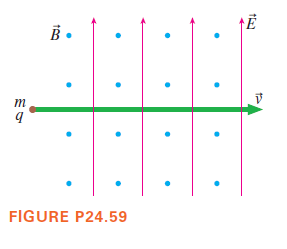In experiments where all the charged particles in a beam are required to have the same velocity (for example, when entering a mass spectrometer), scientists use a velocity selector. A velocity selector has a region of uniform electric and magnetic fields that are perpendicular to each other and perpendicular to the motion of the charged particles. Both the electric and magnetic fields exert a force on the charged particles. If a particle has precisely the right velocity, the two forces exactly cancel and the particle is not deflected. Equating the forces due to the electric field and the magnetic field gives the following equation:
qE = qvB
Solving for the velocity, we get:
ν = (E)/(B)
A particle moving at this velocity will pass through the region of uniform fields with no deflection, as shown. For higher or lower velocities than this, the particles will feel a net force and will be deflected. A slit at the end of the region allows only the particles with the correct velocity to pass.
Assuming the particle given is positively charged, what are the directions of the forces due to the electric field and to the magnetic field?
A. The force due to the electric field is directed up (toward the top of the page); the force due to the magnetic field is directed down (toward the bottom of the page).
B. The force due to the electric field is directed down (toward the bottom of the page); the force due to the magnetic field is directed up (toward the top of the page).
C. The force due to the electric field is directed out of the plane of the paper; the force due to the magnetic field is directed into the plane of the paper.
D. The force due to the electric field is directed into the plane of the paper; the force due to the magnetic field is directed out of the plane of the paper.

Trending now
This is a popular solution!
Step by step
Solved in 2 steps







